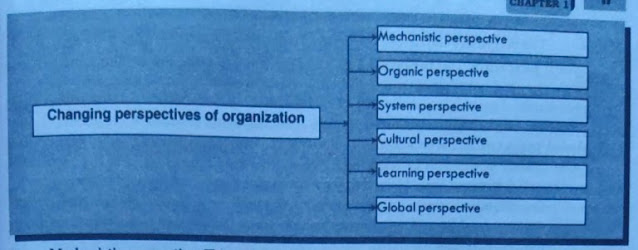The approaches and management styles are being changed in modern organization. Explain the changing perspectives on management.
CHANGING PERSPECTIVE OF ORGANIZATION
The concept about organization has been changing over recent years. Organizational development is being one of the major areas of study from the very beginning of the twentieth century. Traditional views considered organizations as a closed system, operating in a predictable and stable environment but in modern thinking assumes that the organizations are complex entities operating in highly uncertain and unstable environment. The followings are some perspectives of organization:
1. Mechanistic perspective: This is the traditional view on organizations. Many classical theories of organization represent mechanistic view. Many management experts and economists like F.W Taylor, Henry Fayol, Adam Smith, and Moony contributed to develop mechanistic perspective of organization. Mechanistic perspective is characterized by following features:
- This perspective assumes organizations as machines.
- It assumes that organizations operate in a predictable and stable environment.
- According to this perspective, the prime goal of organization is to increase its efficiency through specialization and standardization of work.
- This perspective believes on fixed working hours, fixed production and maintenance schedule, financial control systems and quality control systems to make controlling effective.
- This perspective sets tall organizational structure with formal hierarchy of authority. This perspective sets sales targets to improve profitability.
- This perspective attempts to improve working environment for employee motivation and removing fatigue. This perspective believes on one best way of doing jobs and solving each problem.
Though this perspective is popular among many management practitioners, it has some drawbacks.
- They are: This perspective is suitable only in stable business environment which is almost impossible in current business world. This perspective always ignores human aspects in organization. Thus, employees cannot be motivated.
- This perspective assumes 'unique solution' for every problem.
- There cannot be unique solution to every problem in every organization. Rigid working hours, production schedule and control system makes the organization as a static organization which reduces the chance of goal attainment. .
2. Organic perspective: This is the modern view on organization. It emphasizes on 'socio psychological aspects of human beings in organization. Managers are suggested to analyze sociological and psychological aspects of employees to motivate them. Main features of this approach are listed below:
- This perspective emphasizes on human interactions at work place.
- Social and psychological study of people helps increase organization effectiveness through their motivation.
- This perspective focuses on adjusting with situational change. Thus, change in business environment can be accepted and managed effectively.
- This perspective emphasizes on redesigning the jobs to empower workers.
- Organizations operate in open system. So, each organization should interact with environmental forces. Organizations grab the business opportunities as well as face threats from environment.
- Every system has certain boundary. Such boundary provides the limitation to the organization. Each element of system is goal oriented. The combined effect i.e. synergy of the element provides greater result than just the arithmetic sum of output of each element individually.
- Every system has interrelated sub-systems. For example, within input there can be several systems which are sub-systems for whole system. Feedback provides information regarding the work in progress as well as quality of output. This helps adjust on the system to attain better result. Its main focus is to take the synergic benefits. Synergy here means the whole is always greater than the sum of its parts i.e. 2+2> 4.
- This perspective focuses on mutual interest of management and employees for organizational culture. This helps develop positive effect in organizational performance.
- This perspective is 'people focused'. Thus, mutual understanding, respect and collective efforts are available in the organization.
- This perspective assumes that work autonomy to employees at their work area increases productivity.
- This perspective emphasizes open and two-way communication. Performance based reward system is focused. This perspective believes that culture guides the behaviour and performance of employees at the job.
- Organizational members share ideas and experiences to increase the productivity and organizational effectiveness.
- This perspective focuses on analysis of environment on a regular basis which enables learning faster than competitors.




Comments
Post a Comment